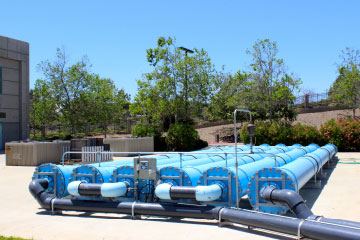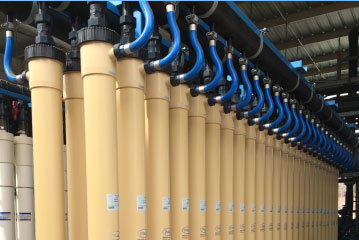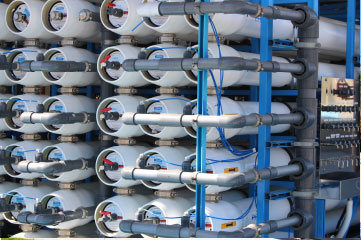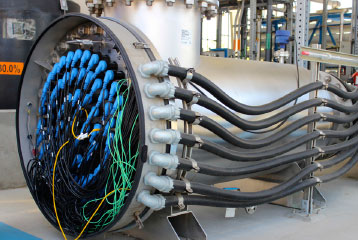Water Purification Offers New Resource
By using water more than once, local water agencies will be able to generate billions of gallons of water each year, helping the semi-arid region continue to thrive.
Purifying water for reuse — also referred to as potable reuse — relies on a multi-barrier treatment process to make recycled water safe to drink. Purified water produced in California with state-of-the-art technologies is higher quality than most bottled water.
Leaders In Potable Reuse
Overview
For more than two decades, water agencies in San Diego County have promoted water reuse as part of the region’s multi-faceted water supply diversification strategy. Today, about 80 percent of the region’s water supplies are transported hundreds of miles from the Colorado River and the State Water Project, which originates in Northern California.
In coming years, potable reuse projects are expected to help water agencies optimize existing infrastructure, increase locally controlled water supplies, and provide environmental benefits while continuing to protect public health. The Water Authority is working with its member agencies through the Potable Reuse Coordination Committee to support development of potable reuse projects in the San Diego region and develop a regulatory framework for direct potable reuse.
By supporting rigorous scientific analysis, securing money for studies, and sponsoring state legislation to speed the adoption of regulations, the Water Authority and its member agencies have become leading advocates for the next generation of locally controlled, drought-resilient drinking water supplies.
Benefits of Potable Reuse
Safe
Generates supplies south of major earthquake fault lines. Meets or exceeds state and federal standards for drinking water.
Sustainable
Locally controlled and drought-resilient.
Environmentally Sound
Reduces wastewater discharges to the ocean and reliance on the Bay-Delta and Colorado River.
FAQs
What is potable reuse?
Potable reuse is the process of purifying wastewater so it can be reused in the drinking water system.
Is planned potable reuse safe?
Yes. The water purification process employs advanced multi-barrier treatment technology. This separates pollutants from the water, purifying it to a level that fully complies with both federal and state drinking water standards. Like other drinking water supplies, it is rigorously tested and publicly reported.
Is anyone drinking recycled wastewater already?
Yes. Reuse occurs when wastewater has been discharged to rivers or lakes, then withdrawn, treated and distributed downstream. For instance, there are more than 300 wastewater outfalls on the Colorado River, a major source of drinking water for Southern California. In this situation, public health is protected through treatment required by the Clean Water Act and Safe Drinking Water Act.
Planned potable reuse started in California in 1962 through groundwater recharge in Los Angeles County. The largest planned potable reuse project is in Orange County, where the water agency has been injecting purified wastewater into an aquifer for decades, then reusing it to serve millions of people each year. Anyone who’s visited Disneyland has drunk potable reuse water.
What are the different uses of recycled water?
Potable reuse refers to purifying wastewater to be drinkable, while non-potable recycling refers to cleaning wastewater to a level acceptable for industrial and irrigation use. The decision on how best to recycle water depends on local infrastructure and the water demands of each agency.
How much water will potable reuse projects generate in San Diego County?
By 2035, potable reuse projects are expected to produce approximately 110,000 acre-feet of water, enough to serve more than 220,000 typical homes. That’s enough water to meet about 16 percent of the forecasted demand in the San Diego region.
Are there environmental benefits to potable reuse?
Potable reuse replaces water that would otherwise have been removed from lakes, rivers or aquifers, then transported — sometimes hundreds of miles – to local homes and businesses. Potable reuse reduces stress on our waterways, and it can reduce wastewater discharges to the ocean.
Purification Processes
Water purification processes and technologies differ, but they generally follow a series of steps shown below to produce high quality water safe for drinking and cooking.
How Purification Technology Works
Want to learn more and dig deeper?
 Potable Reuse Fact Sheet
Potable Reuse Fact Sheet
Local Purification Projects
By using water more than once, local water agencies will be able to generate billions of gallons of water each year, helping the semi-arid region continue to thrive.
Today, leading water agencies in San Diego County are planning potable reuse projects that blend purified water with other drinking water supplies. The purification process relies on similar technology used to turn seawater into drinking water at the Claude “Bud” Lewis Carlsbad Desalination Plant, through filtration and reverse osmosis, plus an additional step using ultraviolet light to meet or exceed stringent standards for drinking water.
Local projects include:
- Pure Water San Diego
- East County Advanced Water Purification Program
- Agricultural and Drinking Water Reuse Project (City of Escondido)
- Pure Water Oceanside (City of Oceanside)
- Potable Reuse Feasibility Study (San Dieguito Water District, Santa Fe Irrigation District, and San Elijo Joint Powers Authority)
- Camp Pendleton Groundwater Recharge Project
- Encina Wastewater Authority Water Augmentation Project



